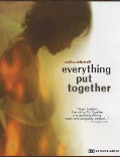
Directed by
Marc Forster
85 minutes
Rated M
Reviewed by
Bernard Hemingway

Everything Put Together
In a case of what is often referred to as "brave" film-making (a code for “commercially unappealing”) Everything Put Together tells the.story of a young woman, Angie (Radha Mitchell), dealing with the death of her newborn from SIDS. Angie has a remote relationship with her mother (British actress and 1960s pin-up girl, Judy Geeson who briefly appears at the end of the film), her friends who don’t know how to respond to her grief shun her, her husband goes back and forth to work and waters the garden and not even a hospital-appointed counsellor is on hand to offer her any succour as she lurches through her emotional distress.
Written by husband and wife team, Adam Forgash and Catherine Lloyd Burns, the latter appearing here as Judith, one of Angie’s fair-weather friends, one assumes that this is derived from real life experience, perhaps that of Burns, and this no doubt contributes considerably to the film's credibility.. Angie's grieving is very much the focus of the film but, probably wisely, it is depicted as profoundly internalized rather than externalized in her relationships with the people around her who all remain peripheral characters. As a result the film at times teeters on the brink of being a psychological horror story with ominously framed kitchen knives and bladed machines featuring prominently, auditory hallucination, eerie music and a visit to the morgue all tending to make us believe that Angie is about to crack as the hand-held digicam swings wildly about or assumes extreme points of view, sometimes going out of focus altogether with cinematographer Roberto Schaefer using changes in colour toning and lighting to convey Angie's disturbed mental state.
All this is contrasted with the mundane world of her conventionally comfortable middle-class suburban idyll of a cheek-to-cheek McMansioned housing estate. Perhaps here the separation between the normal and the abnormal is a little too stark for in the former aspect Angie seems remarkably composed and well-groomed for a woman in extremis. If not entirely effective as realism, at a symbolic level at least we can accept this disconnect (although in part it may have been the function of budgetary considerations).
If anything the film’s major impact is as a withering depiction of suburban conformism as Angie’s friends turn their back on her as if she had intentionally betrayed their middle-class values. The film’s ending seems to recoup Angie to these now thoroughly-discredited women. It’s not an altogether improbable scenario although there is certainly sufficient ambiguity here to suggest alternative readings.
Radha Mitchell, who is also credited as an associate producer, gives an understated but compelling central performance that combined with Foster’s economical direction yields a film that has an emotional yield well beyond its modest scale.
FYI: The film was shot on a budget of US$100,000 with all the actors and crew working without pay.
Want something different?





